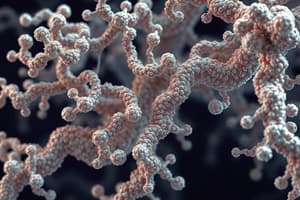Podcast
Questions and Answers
Each organ in the body can choose the necessary amino acids to build its own protein.
Each organ in the body can choose the necessary amino acids to build its own protein.
True (A)
Derived proteins are simple proteins that have not undergone any degradation.
Derived proteins are simple proteins that have not undergone any degradation.
False (B)
Excess amino acids and protein compounds needed for cell growth are stored in the body.
Excess amino acids and protein compounds needed for cell growth are stored in the body.
False (B)
Animal sources of proteins include various types of legumes like beans and lentils.
Animal sources of proteins include various types of legumes like beans and lentils.
Amino acids are the only source of nitrogen necessary for humans or animals.
Amino acids are the only source of nitrogen necessary for humans or animals.
Vegetarian sources of proteins include meat of all kinds, fish, birds, and eggs.
Vegetarian sources of proteins include meat of all kinds, fish, birds, and eggs.
Proteins are the simplest structural units of protein molecules.
Proteins are the simplest structural units of protein molecules.
Amino acids from the blood circulation are converted into animal proteins similar to body proteins under the influence of special cellular enzymes.
Amino acids from the blood circulation are converted into animal proteins similar to body proteins under the influence of special cellular enzymes.
Glycoproteins are formed by the union of proteins with carbohydrates.
Glycoproteins are formed by the union of proteins with carbohydrates.
Nucleoproteins are formed by the union of proteins with lipids.
Nucleoproteins are formed by the union of proteins with lipids.
Albumins are proteins that dissolve in water and coagulate when exposed to heat.
Albumins are proteins that dissolve in water and coagulate when exposed to heat.
Globulins are proteins that dissolve in water.
Globulins are proteins that dissolve in water.
Ribosomes are permanently attached to the rough endoplasmic reticulum.
Ribosomes are permanently attached to the rough endoplasmic reticulum.
A protein-DNA complex is formed when a free ribosome begins translating mRNA for a protein destined for the secretory pathway.
A protein-DNA complex is formed when a free ribosome begins translating mRNA for a protein destined for the secretory pathway.
The smooth endoplasmic reticulum is abundant in most cells.
The smooth endoplasmic reticulum is abundant in most cells.
The rough endoplasmic reticulum synthesizes enzymes for lysosomes and secreted proteins.
The rough endoplasmic reticulum synthesizes enzymes for lysosomes and secreted proteins.
Cells that secrete lipids, phospholipids, and steroids have an abundant smooth endoplasmic reticulum.
Cells that secrete lipids, phospholipids, and steroids have an abundant smooth endoplasmic reticulum.
The transitional endoplasmic reticulum is a region where the reticulum is entirely smooth.
The transitional endoplasmic reticulum is a region where the reticulum is entirely smooth.
Flashcards are hidden until you start studying




